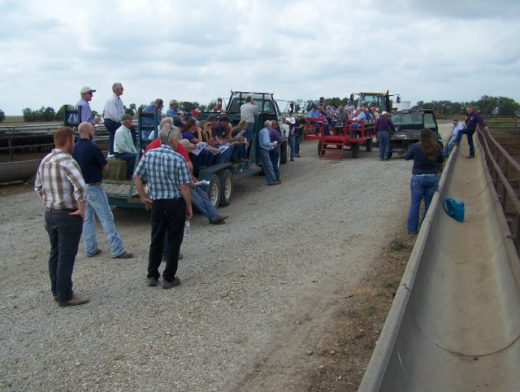By Jeff Davidson, K-State Watershed Specialist
Over fifty local producers, K-State researchers, and other experts gathered for a feedlot field day in early October to discuss the importance of both cattle and feeding facility management. The event showcased the well-designed and managed cattle backgrounding facility owned by Jarret and Shawna Moyer north of Emporia. K-State watershed specialists used the event to stress the importance and value of feedlot management in relation to water quality.
The farmers and ranchers who attended reported a measurable increase in knowledge about the day’s topics, which included: conservation, alternative watering systems, cover crops, site selection, managing runoff, and cattle handling facilities and techniques. Event organizers said that, based on a written evaluation, 83 percent of participants also plan on sharing their new knowledge with other producers. Already, some attendees have reported that they plan to change their home operations to benefit the waters of Kansas.

The discussions had a direct impact on producers’ arrangements for their operations. As a result of what they learned, some producers have made plans to develop alternative watering systems to allow grazing of cover crops, according to Herschel George, K-State watershed specialist. Another cattle producer who, prior to the field day event, was considering building a small feedlot now plans to have his cattle graze cover crops and grass traps and leave his cattle non-confined.
The field day event allowed producers and watershed specialists to discuss the best methods to select pasture size, stocking rate, feed bunk placement and grass buffer areas for non-confined feeding – an alternative to the traditional feedlot feeding pen. Experts agree that rainfall, soils, and topography of the pasture area must be considered when implementing non-confined feeding. Non-confined feeding uses grass traps or crop stubble to hold the cattle, with over 90 percent of the cattle ration being furnished in the bunk.
Cover crops often are used in non-confined feeding systems: while they prove to be valuable in supplying necessary nutrients for animals’ diet, some cover crops have a high moisture content. To offset this, extension experts stressed the importance of having supplemental dry forages available, such as corn stalks, native pasture or even prairie hay. While cover crops can reduce the amount of hay needed for the winter months, a few species can be toxic to cattle, and management strategies must be in place to mitigate that issue.
During the event, participants saw first-hand how the location of a feedlot facility affects water quality. During rainfall events, extraneous drainage, or water from outside the pen area, must be diverted so that only rainwater falling directly in the pen needs to be treated. To do this, a well-maintained grass buffer situated immediately downslope treats the water by slowing the water runoff so it can infiltrate the soil. The grass in the buffer area takes up nutrients carried by the water, which are then removed by haying annually.
Additional pen maintenance includes regular cleaning by scraping the pen surface with a box blade and applying accumulated manure as a fertilizer to crop fields. This decreases the amount of nutrients rainfall will carry from the pen, as well as reduces fly populations.
Experience has shown that the methods used to handle cattle during routine processing and shipping can be either an asset or liability to an operation. Field day participants were able to see the use of a Bud Box, a design for processing cattle that takes the animals’ behavior into account. The result is low-stress processing of cattle, which gives the best response to vaccines: the calves’ immune system responds to stress, and vaccines given during stress do not stimulate the immune system as effectively as desired.
A survey taken by the participants shows that attendees plan to increase cover crop use, better control feeding pen runoff, scrape pens and haul manure more frequently, and some lots will be relocated or redesigned. Handling facilities with the use of a Bud Box to improve the movement of cattle through processing facilities was another area participants targeted for improvement.
“Field days like this one are an important way for local producers to gain new understandings about how their facilities can positively affect water quality in the area,” said Jeff Davidson, K-State watershed specialist.
Feedlot field day sponsors included the Kansas Center for Agricultural Resources and the Environment (KCARE), K-State Research and Extension – Lyon County, Sustainable Agriculture Research and Education (SARE), and Kansas State Research and Extension.